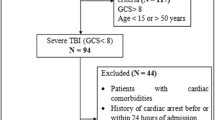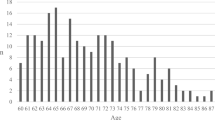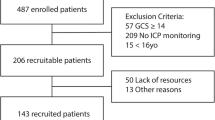Abstract
Background
Posttraumatic cerebral infarction (PTCI) is a severe secondary insult of traumatic brain injury (TBI). This study aimed to evaluate the characteristics and risk factors of PTCI after severe TBI (sTBI) and explore possible mechanism.
Methods
This retrospective study included a cohort of 339 patients with sTBI; they were divided into the PTCI and non-PTCI groups. Clinical data and follow-up charts were reviewed for comparison. The logistic regression model was used for multivariate analysis to detect the risk factors of PTCI. The Glasgow Outcome Scale (GOS) and Barthel index (BI) for activities of daily living (ADL) were applied to evaluate their outcome.
Results
PTCI led to an increased mortality (43.5 % vs. 10.7 %, P < 0.001) and days of intensive care unit stay (14.3 days vs. 7.1 days, P < 0.001), decreased GOS (3.1 vs. 4.1, P < 0.001) and BI (25.0 vs. 77.9, P < 0.001). Increased infarction volume led to poor outcome assessed by GOS (r = −0.46, P < 0.0001) and BI for ADL (r = −0.36, P = 0.026) for surviving patients. Compared with non-PTCI patients, PTCI patients had a high incidence of midline shift (36.2 % vs. 20.7 %, P = 0.011) and posttraumatic vasospasm (PTV) (42.0 % vs. 27.4 %, P = 0.027). Daily prevalence of PTCI occurred in two peaks: one (73.9 %) was in the first 24 h after injury, while the other (18.8 %) was in the span of 43 to 60 h postinjury. In multivariate analysis, hyperthermia [adjusted odds ratio (OR), 3.11; P = 0.001] in the first 24 h, thrombocytopenia (OR, 27.08; P < 0.001), abnormal prothrombin time (OR, 7.66; P < 0.001) and traumatic subarachnoid hemorrhage (OR, 2.33; P = 0.022) were independent predictors for PTCI.
Conclusions
PTCI deteriorates the outcome of sTBI patients. Mechanical compression and hemocoagulative disturbance serve as potential mechanisms mediating this pathophysiological process. PTV may also contribute to PTCI, but its association with PTCI is weak and needs further exploration. Early recognition and intervention of these factors might be beneficial for preventing PTCI.



Similar content being viewed by others
References
Aaslid R (2002) Transcranial Doppler assessment of cerebral vasospasm. Eur J Ultrasound 16:3–10
Andelic N, Anke A, Skandsen T, Sigurdardottir S, Sandhaug M, Ader T, Roe C (2012) Incidence of hospital-admitted severe traumatic brain injury and in-hospital fatality in Norway: a national cohort study. Neuroepidemiology 38:259–267
Bouma GJ, Muizelaar JP, Choi SC, Newlon PG, Young HF (1991) Cerebral circulation and metabolism after severe traumatic brain injury: the elusive role of ischemia. J Neurosurg 75:685–693
Chen H, Xue LX, Guo Y, Chen SW, Wang G, Cao HL, Chen J, Tian HL (2013) The influence of hemocoagulation disorders on the development of posttraumatic cerebral infarction and outcome in patients with moderate or severe head trauma. Biomed Res Int 2013:685174
Frontera JA, Fernandez A, Schmidt JM, Claassen J, Wartenberg KE, Badjatia N, Connolly ES, Mayer SA (2009) Defining vasospasm after subarachnoid hemorrhage: what is the most clinically relevant definition? Stroke 40:1963–1968
Ghajar J (2000) Traumatic brain injury. Lancet 356:923–929
Ham HY, Lee JK, Jang JW, Seo BR, Kim JH, Choi JW (2011) Post-traumatic cerebral infarction : outcome after decompressive hemicraniectomy for the treatment of traumatic brain injury. J Korean Neurosurg Soc 50:370–376
Harrahill M (1997) Management of severe head injury: new document provides guidelines. Brain Trauma Foundation. J Emerg Nurs 23:282–283
Izzy S, Muehlschlegel S (2014) Cerebral vasospasm after aneurysmal subarachnoid hemorrhage and traumatic brain injury. Curr Treat Options Neurol 16:278
Landi A, Marotta N, Mancarella C, Marruzzo D, Salvati M, Delfini R (2011) Basal ganglia stroke due to mild head trauma in pediatric age—clinical and therapeutic management: a case report and 10 year literature review. Ital J Pediatr 37:2
Lindegaard KF, Nornes H, Bakke SJ, Sorteberg W, Nakstad P (1989) Cerebral vasospasm diagnosis by means of angiography and blood velocity measurements. Acta Neurochir (Wien) 100:12–24
Maas AI, Stocchetti N, Bullock R (2008) Moderate and severe traumatic brain injury in adults. Lancet Neurol 7:728–741
Maegele M (2013) Coagulopathy after traumatic brain injury: incidence, pathogenesis, and treatment options. Transfusion 53(Suppl 1):28S–37S
Marino R, Gasparotti R, Pinelli L, Manzoni D, Gritti P, Mardighian D, Latronico N (2006) Posttraumatic cerebral infarction in patients with moderate or severe head trauma. Neurology 67:1165–1171
Martin NA, Doberstein C, Zane C, Caron MJ, Thomas K, Becker DP (1992) Posttraumatic cerebral arterial spasm: transcranial Doppler ultrasound, cerebral blood flow, and angiographic findings. J Neurosurg 77:575–583
Meier U, Grawe A (2003) The importance of decompressive craniectomy for the management of severe head injuries. Acta Neurochir Suppl 86:367–371
Mirvis SE, Wolf AL, Numaguchi Y, Corradino G, Joslyn JN (1990) Posttraumatic cerebral infarction diagnosed by CT: prevalence, origin, and outcome. AJR Am J Roentgenol 154:1293–1298
Mobbs RJ, Chandran KN (2001) Traumatic middle cerebral artery occlusion: case report and review of pathogenesis. Neurol India 49:158–161
Morton RP, Hanak BW, Levitt MR, Fink KR, Peterson EC, Vilela MD, Kim LJ, Chesnut RM (2014) Blunt traumatic occlusion of the internal carotid and vertebral arteries. J Neurosurg 120:1446–1450
Oertel M, Boscardin WJ, Obrist WD, Glenn TC, McArthur DL, Gravori T, Lee JH, Martin NA (2005) Posttraumatic vasospasm: the epidemiology, severity, and time course of an underestimated phenomenon: a prospective study performed in 299 patients. J Neurosurg 103:812–824
Paiva WS, de Andrade AF, Soares MS, Amorim RL, Figueiredo EG, Teixeira MJ (2013) Occlusion of the anterior cerebral artery after head trauma. World J Radiol 5:226–228
Pan A, Li M, Gao JY, Xue ZQ, Li Z, Yuan XY, Luo DW, Luo XG, Yan XX (2013) Experimental epidural hematoma causes cerebral infarction and activates neocortical glial and neuronal genesis in adult guinea pigs. J Neurosci Res 91:249–261
Romner B, Bellner J, Kongstad P, Sjoholm H (1996) Elevated transcranial Doppler flow velocities after severe head injury: cerebral vasospasm or hyperemia? J Neurosurg 85:90–97
Rostami E, Engquist H, Enblad P (2014) Imaging of cerebral blood flow in patients with severe traumatic brain injury in the neurointensive care. Front Neurol 5:114
Server A, Dullerud R, Haakonsen M, Nakstad PH, Johnsen UL, Magnaes B (2001) Post-traumatic cerebral infarction. Neuroimaging findings, etiology and outcome. Acta Radiol 42:254–260
Shahlaie K, Boggan JE, Latchaw RE, Ji C, Muizelaar JP (2009) Posttraumatic vasospasm detected by continuous brain tissue oxygen monitoring: treatment with intraarterial verapamil and balloon angioplasty. Neurocrit Care 10:61–69
Shahlaie K, Keachie K, Hutchins IM, Rudisill N, Madden LK, Smith KA, Ko KA, Latchaw RE, Muizelaar JP (2011) Risk factors for posttraumatic vasospasm. J Neurosurg 115:602–611
Stein SC, Chen XH, Sinson GP, Smith DH (2002) Intravascular coagulation: a major secondary insult in nonfatal traumatic brain injury. J Neurosurg 97:1373–1377
Tawil I, Stein DM, Mirvis SE, Scalea TM (2008) Posttraumatic cerebral infarction: incidence, outcome, and risk factors. J Trauma 64:849–853
Tian HL, Geng Z, Cui YH, Hu J, Xu T, Cao HL, Chen SW, Chen H (2008) Risk factors for posttraumatic cerebral infarction in patients with moderate or severe head trauma. Neurosurg Rev 31:431–436, discussion 436–437
Tu CJ, Liu JS, Song DG, Zhen G, Luo HM, Liu WG, Dong XQ (2011) Maximum thickness of subarachnoid blood is associated with mortality in patients with traumatic subarachnoid haemorrhage. J Int Med Res 39:1757–1765
Vora NA, Shook SJ, Schumacher HC, Tievsky AL, Albers GW, Wechsler LR, Gupta R (2011) A 5-item scale to predict stroke outcome after cortical middle cerebral artery territory infarction: validation from results of the Diffusion and Perfusion Imaging Evaluation for Understanding Stroke Evolution (DEFUSE) Study. Stroke 42:645–649
Wang WH, Hu LS, Lin H, Li J, Luo F, Huang W, Lin JM, Cai GP, Liu CC (2014) Risk factors for post-traumatic massive cerebral infarction secondary to space-occupying epidural hematoma. J Neurotrauma 31:1444–1450
Weber M, Grolimund P, Seiler RW (1990) Evaluation of posttraumatic cerebral blood flow velocities by transcranial Doppler ultrasonography. Neurosurgery 27:106–112
Conflicts of interest
This study was supported by research grants from the National Key Specialist Construction Projects 2011. All authors declare that they have no conflicts of interest or relationships between investigators and research sponsors. The authors have no personal financial or institutional interest in any of the drugs, devices or materials described in this article.
Author information
Authors and Affiliations
Corresponding author
Rights and permissions
About this article
Cite this article
Liu, S., Wan, X., Wang, S. et al. Posttraumatic cerebral infarction in severe traumatic brain injury: characteristics, risk factors and potential mechanisms. Acta Neurochir 157, 1697–1704 (2015). https://doi.org/10.1007/s00701-015-2559-5
Received:
Accepted:
Published:
Issue Date:
DOI: https://doi.org/10.1007/s00701-015-2559-5




